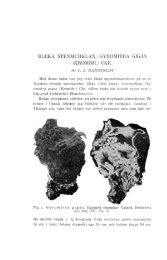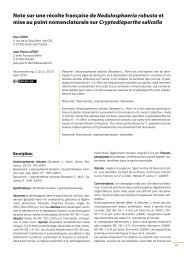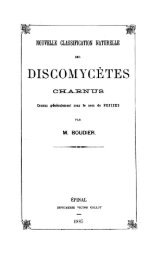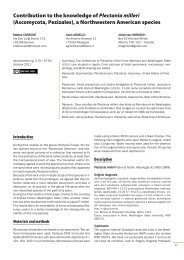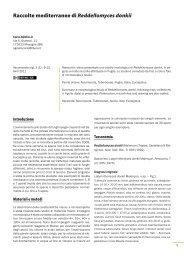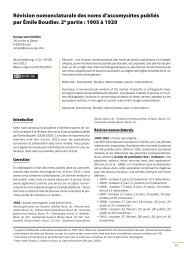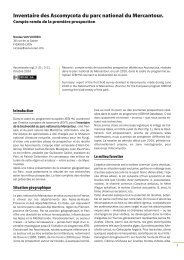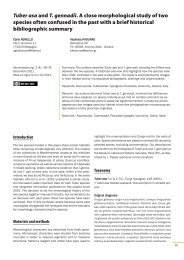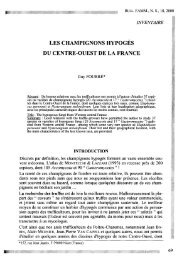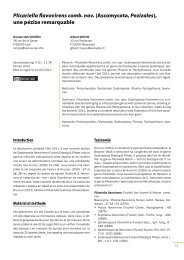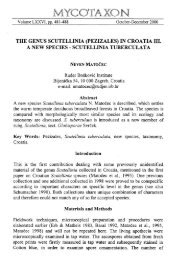some important corrections to the ascomycetes ... - Ascomycete.org
some important corrections to the ascomycetes ... - Ascomycete.org
some important corrections to the ascomycetes ... - Ascomycete.org
Create successful ePaper yourself
Turn your PDF publications into a flip-book with our unique Google optimized e-Paper software.
lacking in smaller ascomata, <strong>the</strong> most convenient current name appears <strong>to</strong> be Lophiotrema<br />
grandisporum (Sacc.) Shoemaker & Babcock (1989).<br />
• Massariosphaeria pusillispora Scheuer 1988. - The different concept for <strong>the</strong><br />
genus Massariosphaeria (E. Muller) Crivelli suggested by Barr (1989, as Chae<strong>to</strong>mastia<br />
(Sacc.) Berl.) also excludes M. pusillispora. Scheuer (1991 a) accommodated a very<br />
similar species in <strong>the</strong> genus Massarina Sacc. (Massarinaceae = Lophios<strong>to</strong>mataceae),<br />
M. tetraploa Scheuer. According <strong>to</strong> a revision of Massarina by Aptroot (1998), M. tetraploa<br />
was not combined in<strong>to</strong> ano<strong>the</strong>r genus. Therefore <strong>the</strong> following new combination is<br />
suggested:<br />
Massarina pusi/lispora (Scheuer) Scheuer comb. novo<br />
Bas.: Massariosphaeria pusi/lispora Scheuer 1988, Biblioth. Mycol. 123: 100.<br />
• Micropeziza cornea (Berk. & Broome) Nannfeldt 1976. - H.O. Baral (pers.<br />
comm.) has re-identified one of Scheuer's (1988) collections as 'Hymenoscyphus'<br />
salmanovicensis Svrcek (1978). All o<strong>the</strong>r collections recorded by Scheuer (1988) are<br />
conspecific. In addition, it must be noted here that this fungus has apparently nothing <strong>to</strong><br />
do with Trochi/a ignobilis P. Karst., a synonym of <strong>the</strong> real Micropeziza cornea (Nannfeldt<br />
1976).<br />
• Monascostroma innumerosum (Desm.) Hohn.; Munk 1957, Muller & Arx 1962.<br />
- Apparently <strong>the</strong> <strong>some</strong>what longitudinal arrangement of <strong>the</strong> finely verruculose<br />
ascospore wall ornament figured by Scheuer (1988) is not a regular feature of <strong>the</strong><br />
ascospore wall surface.<br />
• ?Montagnula spec. indet. - Scheuer (1988) described and figured <strong>the</strong> coarsely<br />
ornamented, dark brown, almost opaque ascospore walls and suggested that this<br />
fungus might be a relative of Montagnula opaca (Wegelin) Crivelli with smaller,<br />
'reduced' ascomata. It should be noted here that Nograsek (1990) did not follow this<br />
suggestion and placed two very similar species in <strong>the</strong> genus Phaeosphaeria Miyake,<br />
viz. Ph. glebosoverrucosa Nograsek and Ph. nanosalicium Nograsek. Lep<strong>to</strong>sphaeria<br />
kochiana E. Muller (1951) is most probably ano<strong>the</strong>r species of this group (E. Muller,<br />
pers. comm.).<br />
• Mycosphaerella hypos<strong>to</strong>matica Hohn.; Tomilin 1979 (erroneously as M. hypostromatica).<br />
- Type material should be compared with Scheuer's (1988) collections <strong>to</strong><br />
assess <strong>the</strong> conspecificity.<br />
• Naeviella paradoxa (Rehm) Clem.; Defago 1968 as Eupropolella p., Nannfeldt<br />
1982. - Scheuer (1988, as 'Naeviella aff. paradoxa1 also recorded a very similar<br />
fungus with slightly shorter ascospores discovered in two collections on Elyna myosuroides<br />
(Viii.) Fritsch. Asci and ascospores from both collections on this host were<br />
figured by Scheuer (1988, Taf. 5, Fig. b and c). Unfortunately, Fig. c was erroneously<br />
labelled Naeviella volkartiana. It shows 'Naeviella aft. paradoxa' on Elyna myosuroides.<br />
• Naeviella poeltiana Scheuer 1988. - This is turning out <strong>to</strong> be a problematic<br />
taxon because of <strong>the</strong> apparent differences in <strong>the</strong> intensity of <strong>the</strong> hemiamyloid (IKI+ red)<br />
reaction of <strong>the</strong> apical ring between different collections. According <strong>to</strong> Nograsek &<br />
Matzer (1994), <strong>the</strong> asci in <strong>the</strong>ir collections of N. poeltiana on Carex firma Mygind show<br />
an IKI- apical ring. On <strong>the</strong> o<strong>the</strong>r hand, a collection on Luzula alpino-pilosa (Chaix)<br />
Breistr. showed a much more intense IKI+ red reaction than <strong>the</strong> type on Carex<br />
ferruginea Scop. (erroneously <strong>the</strong> iodine reaction of <strong>the</strong> collection on Luzula alpinopi/osa<br />
was cited as IKI+ blue by Nograsek & Matzer 1994).<br />
37



